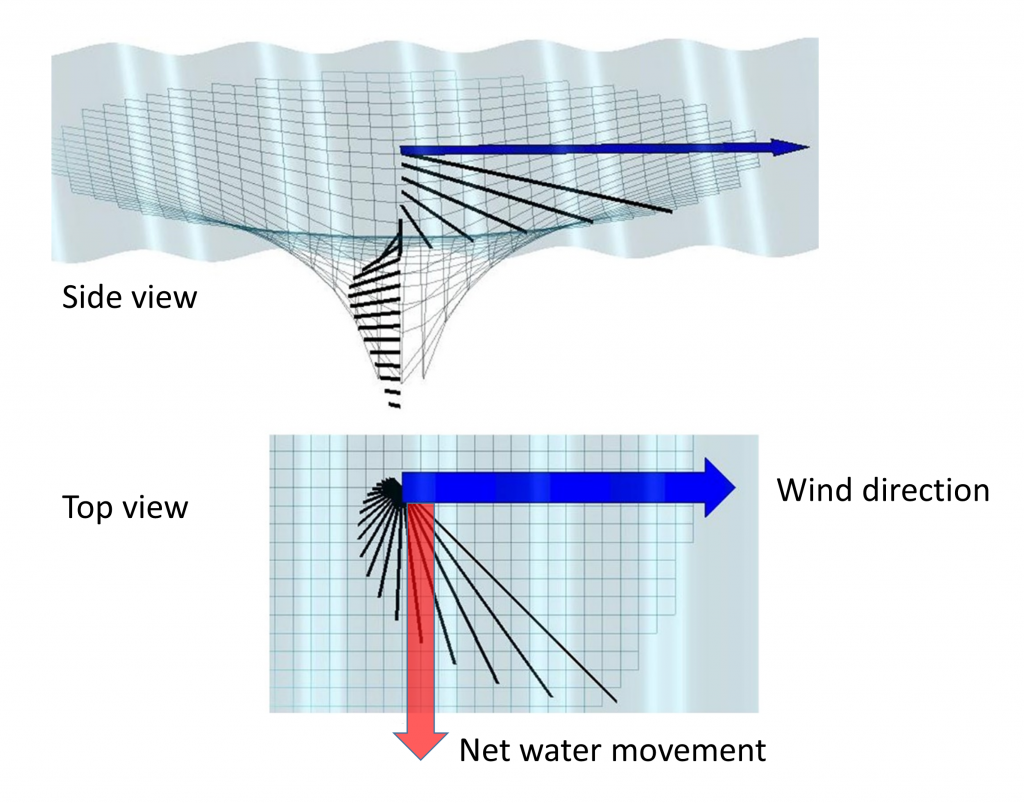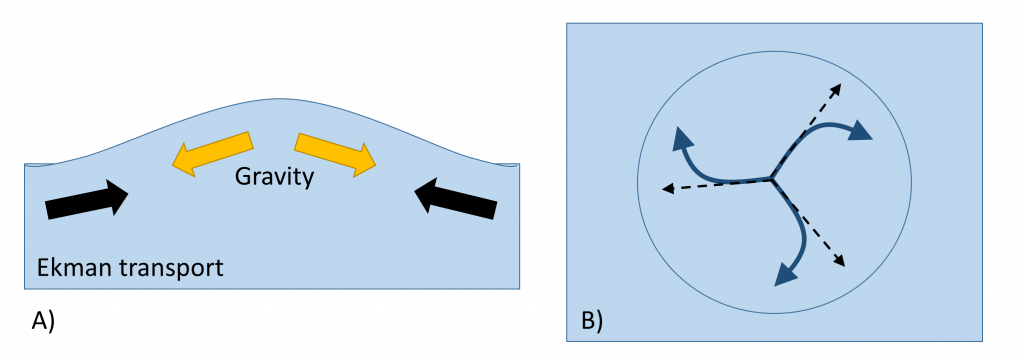9.3 The Ekman Spiral and Geostrophic Flow
Paul Webb
Ekman spiral
Winds blowing over the ocean are ultimately what create the surface currents. However, not all of the water moved by the surface currents is transported in the same direction. The Coriolis Effect causes the surface water to move in a direction about 45 degrees offset from the wind direction, with the deflection to the right of the wind in the Northern Hemisphere and to the left in the Southern Hemisphere. The frictional movement of the topmost layer of water sets in motion the layer directly underneath it, which then sets in motion the next layer under that, and so on as the water gets deeper. Some energy is lost in each transition, so each successive layer of water will not move as far as the layer above it; in other words, there is decreasing energy with increasing depth. But at the same time, the Coriolis Effect deflects each layer relative to the layer above it (again, to the right in the Northern Hemisphere and to the left in the Southern Hemisphere). The movement of the successive layers therefore creates a spiraling pattern of water motion called the Ekman spiral, which usually penetrates to about 100 m deep before the motion ceases. If the magnitudes and directions of the movements of each layer are added together, the result is that the net movement of the upper 100 m of the water column is 90o relative to the original wind direction (90o to the right of the wind in the Northern Hemisphere, and 90o to the left in the Southern Hemisphere). This net water movement is called Ekman transport (Figure 9.3.1).

Geostrophic flow
Gyre rotation is dependent on the wind and the Coriolis Effect impacting the surface currents (see section 9.1). But the rotation is also affected by movement below the surface due to Ekman transport. In the Northern Hemisphere, as the gyre rotates clockwise the net movement of the Ekman transport is 90o to the right of the wind; in other words, towards the center of the gyre. The Ekman transport piles up water in the center of the gyre, making the water level higher in the gyre center than on the edges of the gyres. This pile of water then has a tendency to flow back “downhill” due to gravity. As the water flows “downhill” away from the gyre center, it is deflected to the right by the Coriolis force. This results in a clockwise current around the central “hill” called geostrophic flow, which moves in the same direction as the rotating gyre. Water is thus pushed into the “hill” by Ekman transport, and away from the “hill” by gravity, with both flows modified by the Coriolis Effect to create the rotation. As with the gyres, geostrophic flow is clockwise in the Northern Hemisphere, and counterclockwise in the Southern Hemisphere.

Most major surface currents are a combination of wind-driven and geostrophic currents. Since winds can be variable, geostrophic flow ensure that the gyre currents keep moving at a fairly constant rate even when the wind dies down. The larger the area, and the higher the slope, the longer the geostrophic flow will continue to move and power the gyre after the wind subsides.
the tendency for the path of moving bodies (e.g., ocean currents) to be deflected on the surface of the Earth, to the right in the Northern Hemisphere and to the left in the Southern Hemisphere (8.2)
where each layer of water is deflected relative to the layer above it, forming a spiral that extends down to about 100 m (9.3)
bulk transport of water due to the Ekman spiral; the net movement Ekman transport is 90 degrees relative to the wind direction (9.3)
a large circular ocean surface current (9.1)
circular currents created from the balance between gravity- and Ekman-driven flow (9.3)

